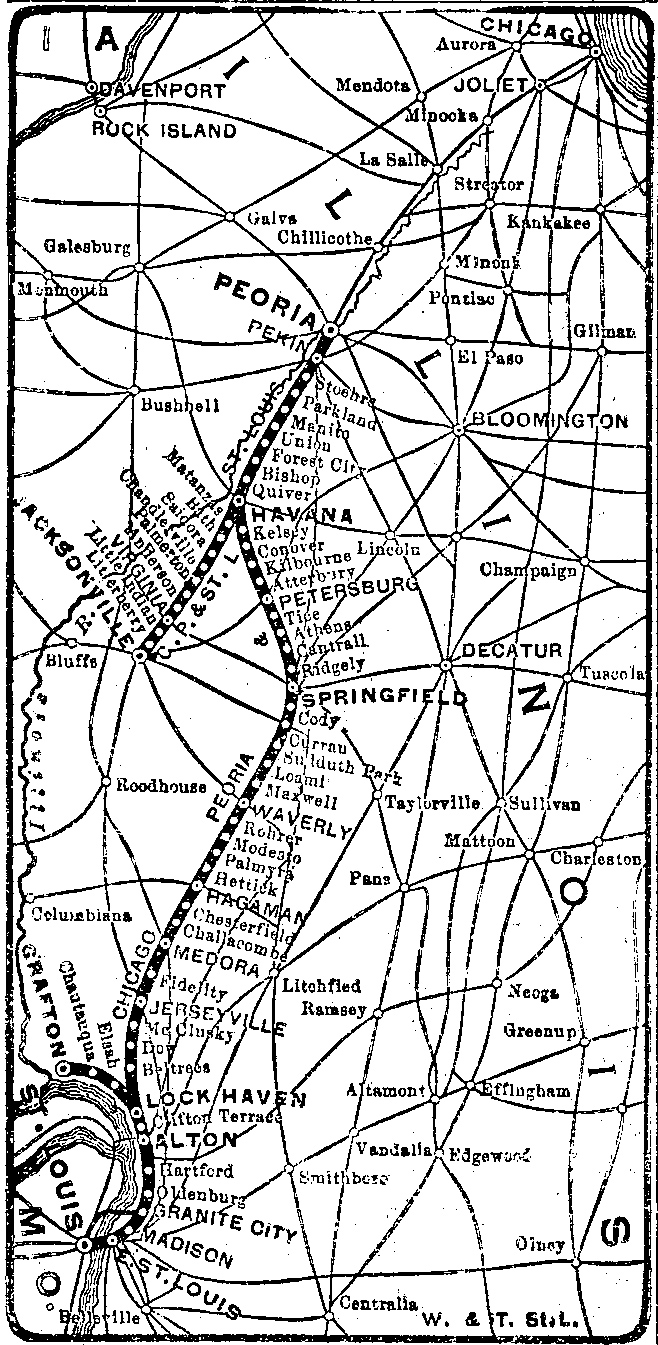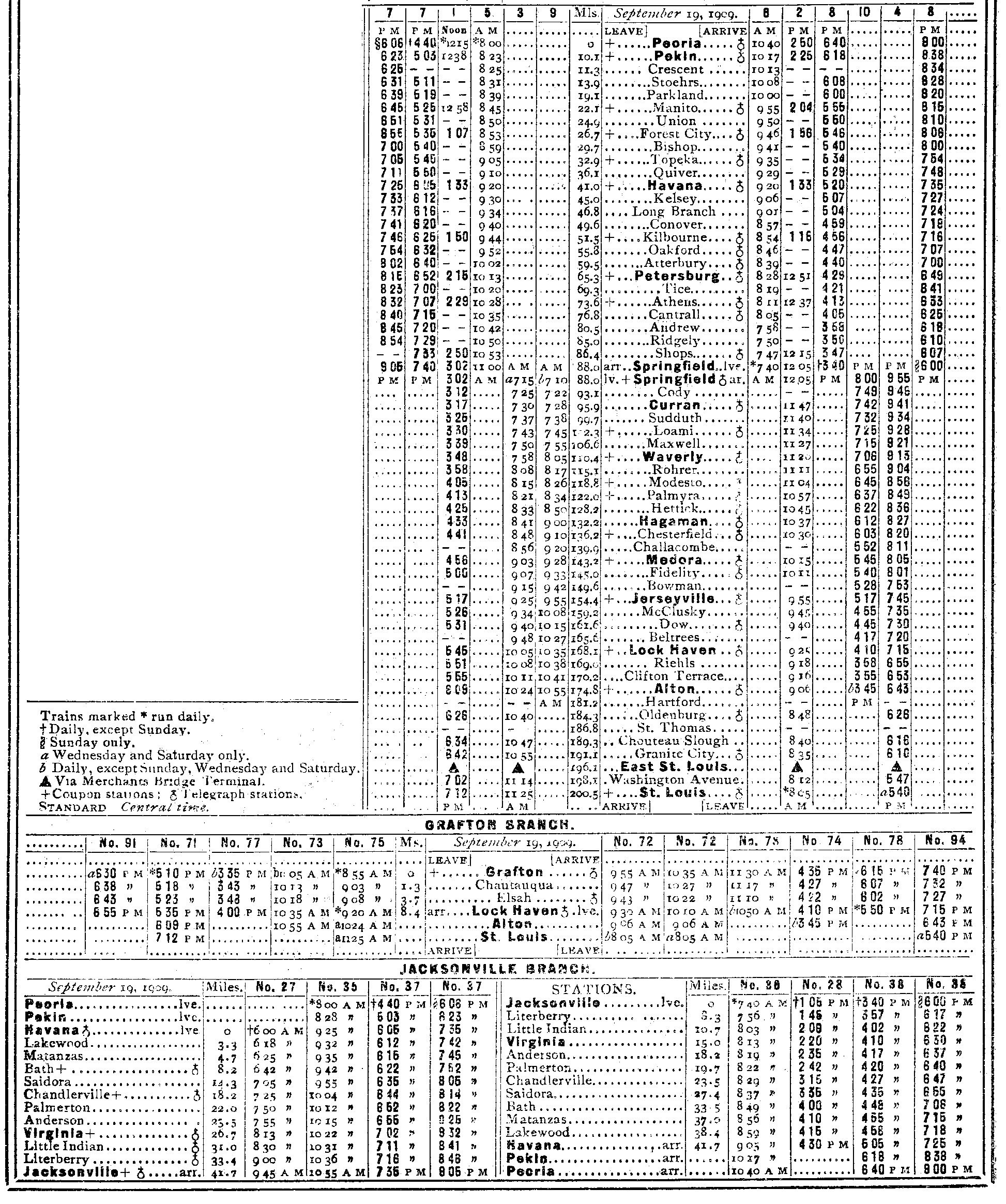Chicago, Peoria & St. Louis Railroad: Frought with Financial Issues
Published: February 4, 2025
By: Adam Burns
The Chicago, Peoria & St. Louis Railroad (CP&StL), while often overlooked within the broader scope of American railroad history, was once a notable system connecting St. Louis and Peoria with a history tracing as far back as 1853.
During the age when railroads were the lifeblood of industrial growth and societal transformation, CP&StL emerged as a vital connector for local economies and communities within Illinois. However, like many other regional systems of the era, it faced challenges of much more prosperous lines serving much larger markets.
Following years of financial difficulty, the property underwent foreclosure and was subsequently sold to a handful of other railroads. The segment extending north of Springfield evolved into the Chicago & Illinois Midland (today, the Illinois & Midland).
Meanwhile, the rest of the line was largely abandoned, with the exception of a section near St. Louis, which is currently operated by Norfolk Southern. The history of the CP&StL is a tale of ambition, competition, and adaptation.
System Map (1909)
Early History
The Illinois River Railroad was the earliest component of what later became the Chicago, Peoria and St. Louis Railway (CP&StL). It was established under a charter by the Illinois General Assembly in February 1853.
This charter envisioned a rail line extending from Jacksonville to La Salle via the Illinois River Valley. The section from Virginia to Pekin entered service in 1859. Subsequently, in May 1864, following foreclosure, ownership transferred to the newly-formed Peoria, Pekin & Jacksonville Railroad (PP&J).
This enterprise later acquired an additional route from Pekin to Peoria in May 1868 from the Peoria & Hannibal Railroad. By 1869, the line had further expanded southwest to the Toledo, Wabash & Western Railway (Wabash) at Jacksonville. The segment obtained beyond Pekin in 1868 was eventually sold in November 1880 to the Peoria & Pekin Union Railway, a small terminal road.
A separate line, the Springfield & Northwestern Railroad, was chartered in March 1869 to build a route from Springfield to Rock Island. By December 1874 the line was completed from Springfield to Havana but required trackage rights over the PP&J to reach Peoria.
Both lines were acquired in 1881 by the Wabash. However, following that railroad's bankrupcty the system was reorganized as the Chicago, Peoria & St. Louis Railway, a subsidiary of the Jacksonville Southeastern Railway.
This parent company was later reorganized in 1890 as the Jacksonville, Louisville & St. Louis Railway. This system further expanded that same year by leasing the St. Louis & Chicago Railway, which connected Springfield and Litchfield, and then extended further south to Madison by year's end.
The CP&StL was typical of many Midwestern railroads in that it functioned primarily as a regional carrier. Its main lines and branches hauled typical freight of that era; less-than-carload (LCL), agricultural products, and general manufacturing. In addition, the railroad provided modest passenger service.
However, by the early 20th century the road was struggling due to larger competitors such as the Illinois Central, Wabash, and the Alton Railroad that linked Chicago and St. Louis directly. As a result, the CP&StL could not compete with these expansive, well-capitalized entities.
Financial Issues and Final Years
The Chicago, Peoria and St. Louis Railway was reorganized in January 1896 as the Chicago, Peoria and St. Louis Railroad of Illinois. This reorganization included its original connections from Pekin to Jacksonville and Springfield, alongside a disconnected extension from Litchfield to Madison.
Without direct access from Springfield to Litchfield, the CP&StL negotiated trackage rights over the St. Louis, Chicago & St. Paul Railroad, known as the "Bluff Line," to reach Waverly, and further over the Jacksonville Southeastern to Litchfield.
By July 1896, the pathway was altered to utilize the line between Jacksonville and Litchfield. In March 1900, the CP&StL obtained the Bluff Line as its St. Louis connection and divested the Litchfield-Madison route.
In its final form the CP&StL comprised a main line extending from Pekin to Granite City/Madison, with branches leading to Jacksonville and Grafton.
The Chicago, Peoria & St. Louis Railroad, incorporated in December 1909, assumed control of the previous company's assets in January 1913. The decline in profitability due to market saturation and rising operational costs resulted in little hope for the system to remaing in service.
Operations persisted until November 1924, when foreclosure resulted in the division of the property among four separate companies:
1. The Alton & Eastern Railroad acquired the segment from Granite City to Grafton - which served several industries - including the Alton Terminal Railway lease, later leased to the Illinois Terminal in 1930 and merged in 1937; this is now part of the Norfolk Southern.
2. The Chicago, Springfield & St. Louis Railway took over the Lockhaven to Springfield segment, which was eventually abandoned.
3. The Springfield, Havana & Peoria Railroad picked up the Springfield to Pekin section, leased it to the Chicago & Illinois Midland Railway in 1926. The C&IM would fully acquire this line in 1936. It is currently operated by the Illinois and Midland Railroad.
4. The Jacksonville & Havana Railroad operated from Jacksonville to Havana, which was eventually abandoned.
Timetables (1909)
Legacy
Despite its absorption, the legacy of the CP&StL remains embedded in the communities it once served, and in the broader narrative of midwestern history.
Its routes laid the foundation for continued rail service in some parts of Illinois, and the economic connections forged by its tracks contributed to the growth and prosperity of towns and cities within its reach.
The story of the CP&StL is emblematic of many smaller railroads during that era—marked by ambition and vision, but ultimately consumed by industrial evolution and the inexorable march of technological progress.
Today, while the Chicago Peoria & St. Louis is no longer operational as an independent entity, it serves as a historical reference point, illustrating the powerful role railroads played in shaping American commerce and community development in the late 19th and early 20th centuries.
Recent Articles
-
Arizona Polar Express Train Rides: A Complete Guide
Mar 13, 25 11:55 AM
Arizona is home to one of the finest heritage railroads in the nation, the Grand Canyon Railway. During the holiday season they host official "The Polar Express" trips. -
Oklahoma Polar Express Train Rides: A Complete Guide
Mar 13, 25 11:06 AM
Oklahoma is one of just a handful of states offering official "The Polar Express" events, hosted at the Oklahoma Railway Musuem in Oklahoma City. Learn more about this attraction here! -
Milwaukee Road Steam Roster (All-Time): Post-1900
Mar 13, 25 12:19 AM
The Milwaukee Road is best known for its fleet of streamlined 4-4-2s and 4-6-4s which led the "Hiawathas." However, it also operated many other designs. This information highlights its post-1900 steam…





